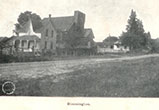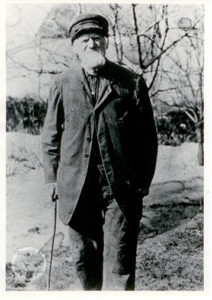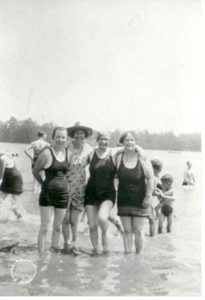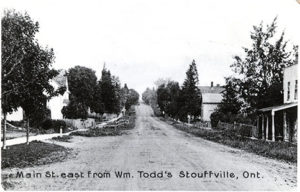
Baker Hill
Baker Hill was named after the Baker family who were descendants of Jacob and Anne Marie (nee Brecht) Baker, who settled in the area in
Archaeology has shown that the area we know today as Whitchurch-Stouffville was occupied as early as the late sixteenth century. Visit Archaeology Alive! The Jean-Baptiste Lainé Site in Whitchurch Stouffville Virtual Exhibit to learn about the Northern Iroquoian settlement now known as the Jean-Baptiste Lainé Site that was home to approximately 2,000 ancestral Wendat.
European Settlers arrived in Whitchurch Township as early as 1794. At that time at least three Indigenous trail systems were in use. The Mississauga claim to portions of Whitchurch are on record from the time of the very first attempt by settlers to take up residence in the Township. In 1923 Whitchurch was included as part of the Williams Treaties.
Whitchurch Township was originally 59,743 acres (24,178 hectares) in size. The Township was named c. 1798 by Colonel John Graves Simcoe, first Lieutenant Governor of Upper Canada, after the birthplace of his wife in Whitchurch, Herefordshire, England. The boundaries of the Township were present day Davis Drive, Yonge Street, Stouffville Road, and Durham Regional Road 30.
With the implementation of the Baldwin Act, the Township of Whitchurch became an organized municipal government in 1850, with a Reeve (Joseph Hartman) & appointed Councillors. While maintaining their names, existing hamlets were absorbed into this newly formed Township. The inaugural meeting of the municipal government of the Township of Whitchurch was held at Smith’s Inn in Stouffville on January 6, 1851.
Three hamlets grew into villages and separated from Whitchurch Township for administrative purposes to form their own municipal governments in the following years. They were Newmarket (1858), Aurora (1863), and Stouffville (1877).
Boundary changes took place in 1967 at the request of York County which resulted in the creation of the Regional Municipality of York on January 1, 1971. After much discussion & debate the result was that the fourteen municipalities that existed were amalgamated into nine.
With boundaries redrawn, Whitchurch Township & the Village of Stouffville would come together to form the “Whitchurch Area” as one of the 9 newly formed municipal governments. The option existed for the name to be changed through consensus and the Town of Whitchurch-Stouffville was selected. In 2019, the Town began using the name “Stouffville” for marketing purposes although the name Whitchurch-Stouffville remains the official name of the municipality.

Baker Hill was named after the Baker family who were descendants of Jacob and Anne Marie (nee Brecht) Baker, who settled in the area in

Ballantrae was settled in the early 1800s and became a busy economic centre for the surrounding lumber trade. This community had several hotels, blacksmiths, general

The hamlet of Bethesda was clustered around the four corners of Warden Avenue and Bethesda Road. Bethesda was known for many outdoor religious camp meetings

Bloomington, the community located at the intersection of Bloomington Road and Ninth Line, was named by Maxson Jones in 1869 after his hometown in Illinois.

Sawmills and gristmills were early industries for Cedar Valley, operating with power from Taylor Creek. The community, located at the intersection of Vivian Road and

A hillside church on the Hill family farm explains the origin of the name Churchill. William Hill came to the area around Ninth Line and

Gormley was named after James Gormley who ran a general store and post office at Stouffville Road and Woodbine Avenue. Gormley came to this area

This small German hamlet was once located at the intersection of McCowan (7th Line) and Stouffville Road. It was 1 ¼ miles west of Ringwood.

Primarily a farming community, Hartman was named after Joseph H. Hartman of Petchville, a well-respected figure in that community. Hartman, despite being the namesake, never

Located at Durham Regional Road 30 and Aurora Road is a kettle lake with an island, hence the name Island Lake. Farmers were attracted to

The Lemonville community, located south of Bloomington Road on McCowan Road, was named after George Lemon, who received his land grant here in 1805. A

Lincolnville was located at the corner of Bloomington Road and Highway 47 and was divided between Uxbridge and Whitchurch Townships. The tall pines in the

The community of Musselman’s Lake is named after the Musselman family who bought land surrounding the kettle lake in 1807. Peter and Jacob Musselman came

Pine Orchard, the community at Warden Avenue and Vivian Road, was settled in 1802 by Quaker families who emigrated from Pennsylvania. In 1814, the first

Known initially as Pleasant Valley, this hamlet was originally settled by Quaker families including the Widdifields, Tooles, Willsons, Lundys and Starrs. The property on the

Originally known as Reesor Lake and then Middleton Lake at the turn of the 20th century, the are was ultimately named after the Preston family

Ringwood was settled by the Fockler family in the late 1790s at the four corners of Markham Road and Stouffville Road. Nicknamed “Circle City” by

At McCowan Road, north of the Aurora Road, the road ends at a deep gully. This is the hamlet of Seldom Seen. It was not

The small hamlet of Shrubmount was settled at the intersection of Davis Drive and McCowan Road. Although the origin of the name is not known,

Initially a hamlet of Whitchurch Township, Stouffville got its name from Abraham Stauffer (Stouffer) who emigrated to the area in 1804. The community sprang up

Originally known as “Brookvale,” the community situated at Vandorf Sideroad and Woodbine Avenue had to be renamed in 1887 when the post office was opened

This hamlet was originally known as Sexsmith’s Corners after George Sexsmith, who operated a general store and inn. He was also the first postmaster. The

The community of Wesley Corners, located at the crossroads of Woodbine Avenue and Aurora Road, was originally called Hacking’s Corners after Rev. James Hacking, a
© 2024 Town of Whitchurch-Stouffville